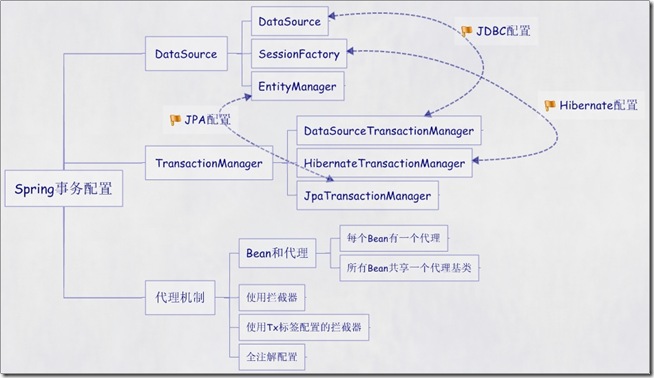Spring声明式事务总结
Spring配置文件中关于事务配置总是由三个组成部分,分别是DataSource、TransactionManager和代理机制这三部分,无论哪种配置方式,一般变化的只是代理机制这部分。
DataSource、TransactionManager这两部分只是会根据数据访问方式有所变化,比如使用Hibernate进行数据访问时,DataSource实际为SessionFactory,TransactionManager的实现为HibernateTransactionManager。
具体如下图:

#一个完整的常用的配置方便的事务配置例子
<!-- 配置dataSource -->
<bean id="dataSource" class="com.mchange.v2.c3p0.ComboPooledDataSource" destroy-method="close">
<property name="driverClass" value="${driverClass}"></property>
<property name="jdbcUrl" value="${jdbcUrl}"></property>
<property name="user" value="${user}"></property>
<property name="password" value="${password}"></property>
</bean> <!-- 配置transactionManager -->
<bean id="transactionManager" class="org.springframework.orm.hibernate3.HibernateTransactionManager">
<property name="sessionFactory" ref="sessionFactory"/>
</bean> <!-- 定义事务处理规则(通知):service接口方法名,以什么开头有事务或没事务 -->
<tx:advice id="txAdvice" transaction-manager="transactionManager">
<tx:attributes>
<!-- 事务传播属性、隔离级别、最优化为只读事务、事务超时 -->
<tx:method name="*" propagation="REQUIRED" isolation="DEFAULT" read-only="true" timeout="-1"/>
</tx:attributes>
</tx:advice> <aop:config>
<!-- 定义切面(事务要控制在哪些层,即哪些包下) -->
<aop:pointcut id="pointcutId" expression="execution(* com.google.code..*.*Service.*(..))"/>
<!-- 定义织入点规则 -->
<aop:advisor advice-ref="txAdvice" pointcut-ref="pointcutId"/>
</aop:config>
根据代理机制的不同,总结了五种Spring事务的配置方式,配置文件如下:
第一种方式:每个Bean都有一个代理
<?xml version="1.0" encoding="UTF-8"?>
<beans xmlns="http://www.springframework.org/schema/beans"
xmlns:xsi="http://www.w3.org/2001/XMLSchema-instance" xmlns:context="http://www.springframework.org/schema/context"
xmlns:aop="http://www.springframework.org/schema/aop"
xsi:schemaLocation="http://www.springframework.org/schema/beans
http://www.springframework.org/schema/beans/spring-beans-2.5.xsd
http://www.springframework.org/schema/context
http://www.springframework.org/schema/context/spring-context-2.5.xsd
http://www.springframework.org/schema/aop http://www.springframework.org/schema/aop/spring-aop-2.5.xsd"> <bean id="sessionFactory" class="org.springframework.orm.hibernate3.LocalSessionFactoryBean">
<property name="configLocation" value="classpath:hibernate.cfg.xml" />
<property name="configurationClass" value="org.hibernate.cfg.AnnotationConfiguration" />
</bean> <!-- 定义事务管理器(声明式的事务) -->
<bean id="transactionManager" class="org.springframework.orm.hibernate3.HibernateTransactionManager">
<property name="sessionFactory" ref="sessionFactory" />
</bean> <!-- 配置DAO -->
<bean id="userDaoTarget" class="com.bluesky.spring.dao.UserDaoImpl">
<property name="sessionFactory" ref="sessionFactory" />
</bean> <bean id="userDao" class="org.springframework.transaction.interceptor.TransactionProxyFactoryBean">
<!-- 配置事务管理器 -->
<property name="transactionManager" ref="transactionManager" />
<property name="target" ref="userDaoTarget" />
<property name="proxyInterfaces" value="com.bluesky.spring.dao.GeneratorDao" />
<!-- 配置事务属性 -->
<property name="transactionAttributes">
<props>
<prop key="*">PROPAGATION_REQUIRED</prop>
</props>
</property>
</bean>
</beans>
第二种方式:所有Bean共享一个代理基类
......
<bean id="sessionFactory" class="org.springframework.orm.hibernate3.LocalSessionFactoryBean">
<property name="configLocation" value="classpath:hibernate.cfg.xml" />
<property name="configurationClass" value="org.hibernate.cfg.AnnotationConfiguration" />
</bean> <!-- 定义事务管理器(声明式的事务) -->
<bean id="transactionManager" class="org.springframework.orm.hibernate3.HibernateTransactionManager">
<property name="sessionFactory" ref="sessionFactory" />
</bean> <bean id="transactionBase" class="org.springframework.transaction.interceptor.TransactionProxyFactoryBean" lazy-init="true" abstract="true">
<!-- 配置事务管理器 -->
<property name="transactionManager" ref="transactionManager" />
<!-- 配置事务属性 -->
<property name="transactionAttributes">
<props>
<prop key="*">PROPAGATION_REQUIRED</prop>
</props>
</property>
</bean> <!-- 配置DAO -->
<bean id="userDaoTarget" class="com.bluesky.spring.dao.UserDaoImpl">
<property name="sessionFactory" ref="sessionFactory" />
</bean> <bean id="userDao" parent="transactionBase">
<property name="target" ref="userDaoTarget" />
</bean>
第三种方式:使用拦截器
......
<bean id="sessionFactory" class="org.springframework.orm.hibernate3.LocalSessionFactoryBean">
<property name="configLocation" value="classpath:hibernate.cfg.xml" />
<property name="configurationClass" value="org.hibernate.cfg.AnnotationConfiguration" />
</bean> <!-- 定义事务管理器(声明式的事务) -->
<bean id="transactionManager" class="org.springframework.orm.hibernate3.HibernateTransactionManager">
<property name="sessionFactory" ref="sessionFactory" />
</bean> <bean id="transactionInterceptor" class="org.springframework.transaction.interceptor.TransactionInterceptor">
<property name="transactionManager" ref="transactionManager" />
<!-- 配置事务属性 -->
<property name="transactionAttributes">
<props>
<prop key="*">PROPAGATION_REQUIRED</prop>
</props>
</property>
</bean> <bean class="org.springframework.aop.framework.autoproxy.BeanNameAutoProxyCreator">
<property name="beanNames">
<list>
<value>*Dao</value>
</list>
</property>
<property name="interceptorNames">
<list>
<value>transactionInterceptor</value>
</list>
</property>
</bean> <!-- 配置DAO -->
<bean id="userDao" class="com.bluesky.spring.dao.UserDaoImpl">
<property name="sessionFactory" ref="sessionFactory" />
</bean>
第四种方式:使用tx标签配置的拦截器
<?xml version="1.0" encoding="UTF-8"?>
<beans xmlns="http://www.springframework.org/schema/beans"
xmlns:xsi="http://www.w3.org/2001/XMLSchema-instance"
xmlns:context="http://www.springframework.org/schema/context"
xmlns:aop="http://www.springframework.org/schema/aop"
xmlns:tx="http://www.springframework.org/schema/tx"
xsi:schemaLocation="http://www.springframework.org/schema/beans
http://www.springframework.org/schema/beans/spring-beans-2.5.xsd
http://www.springframework.org/schema/context
http://www.springframework.org/schema/context/spring-context-2.5.xsd
http://www.springframework.org/schema/aop http://www.springframework.org/schema/aop/spring-aop-2.5.xsd
http://www.springframework.org/schema/tx http://www.springframework.org/schema/tx/spring-tx-2.5.xsd">
<context:annotation-config />
<context:component-scan base-package="com.bluesky" /> <bean id="sessionFactory" class="org.springframework.orm.hibernate3.LocalSessionFactoryBean">
<property name="configLocation" value="classpath:hibernate.cfg.xml" />
<property name="configurationClass" value="org.hibernate.cfg.AnnotationConfiguration" />
</bean> <!-- 定义事务管理器(声明式的事务) -->
<bean id="transactionManager" class="org.springframework.orm.hibernate3.HibernateTransactionManager">
<property name="sessionFactory" ref="sessionFactory" />
</bean> <tx:advice id="txAdvice" transaction-manager="transactionManager">
<tx:attributes>
<tx:method name="*" propagation="REQUIRED" />
</tx:attributes>
</tx:advice> <aop:config>
<aop:pointcut id="interceptorPointCuts" expression="execution(* com.bluesky.spring.dao.*.*(..))" />
<aop:advisor advice-ref="txAdvice" pointcut-ref="interceptorPointCuts" />
</aop:config>
</bean>
第五种方式:全注解
......
<context:annotation-config />
<context:component-scan base-package="com.bluesky" /> <tx:annotation-driven transaction-manager="transactionManager" /> <bean id="sessionFactory" class="org.springframework.orm.hibernate3.LocalSessionFactoryBean">
<property name="configLocation" value="classpath:hibernate.cfg.xml" />
<property name="configurationClass" value="org.hibernate.cfg.AnnotationConfiguration" />
</bean> <!-- 定义事务管理器(声明式的事务) -->
<bean id="transactionManager" class="org.springframework.orm.hibernate3.HibernateTransactionManager">
<property name="sessionFactory" ref="sessionFactory" />
</bean>
此时在DAO上需加上@Transactional注解,如下:
@Transactional
@Component("userDao")
public class UserDaoImpl extends HibernateDaoSupport implements UserDao {
public List<User> listUsers() {
return this.getSession().createQuery("from User").list();
}
......
}
2、事务的传播属性(Propagation)
Propagation :key属性确定代理应该给哪个方法增加事务行为。这样的属性最重要的部份是传播行为。有以下选项可供使用:PROPAGATION_REQUIRED--支持当前事务,如果当前没有事务,就新建一个事务。这是最常见的选择。
PROPAGATION_REQUIRED--支持当前事务,如果当前没有事务,就新建一个事务。这是最常见的选择。
PROPAGATION_SUPPORTS--支持当前事务,如果当前没有事务,就以非事务方式执行。
PROPAGATION_MANDATORY--支持当前事务,如果当前没有事务,就抛出异常。
PROPAGATION_REQUIRES_NEW--新建事务,如果当前存在事务,把当前事务挂起。
PROPAGATION_NOT_SUPPORTED--以非事务方式执行操作,如果当前存在事务,就把当前事务挂起。
PROPAGATION_NEVER--以非事务方式执行,如果当前存在事务,则抛出异常。
1: PROPAGATION_REQUIRED
加入当前正要执行的事务不在另外一个事务里,那么就起一个新的事务。
比如说,ServiceB.methodB的事务级别定义为PROPAGATION_REQUIRED, 那么由于执行ServiceA.methodA的时候,ServiceA.methodA已经起了事务,这时调用ServiceB.methodB,ServiceB.methodB看到自己已经运行在ServiceA.methodA的事务内部,就不再起新的事务。而假如ServiceA.methodA运行的时候发现自己没有在事务中,他就会为自己分配一个事务。这样,在ServiceA.methodA或者在ServiceB.methodB内的任何地方出现异常,事务都会被回滚。即使ServiceB.methodB的事务已经被提交,但是ServiceA.methodA在接下来fail要回滚,ServiceB.methodB也要回滚
2: PROPAGATION_SUPPORTS
如果当前在事务中,即以事务的形式运行,如果当前不再一个事务中,那么就以非事务的形式运行
3: PROPAGATION_MANDATORY
必须在一个事务中运行。也就是说,他只能被一个父事务调用。否则,他就要抛出异常
4: PROPAGATION_REQUIRES_NEW
这个就比较绕口了。 比如我们设计ServiceA.methodA的事务级别为PROPAGATION_REQUIRED,ServiceB.methodB的事务级别为PROPAGATION_REQUIRES_NEW,那么当执行到ServiceB.methodB的时候,ServiceA.methodA所在的事务就会挂起,ServiceB.methodB会起一个新的事务,等待ServiceB.methodB的事务完成以后,他才继续执行。他与PROPAGATION_REQUIRED 的事务区别在于事务的回滚程度了。因为ServiceB.methodB是新起一个事务,那么就是存在两个不同的事务。如果ServiceB.methodB已经提交,那么ServiceA.methodA失败回滚,ServiceB.methodB是不会回滚的。如果ServiceB.methodB失败回滚,如果他抛出的异常被ServiceA.methodA捕获,ServiceA.methodA事务仍然可能提交。
5: PROPAGATION_NOT_SUPPORTED
当前不支持事务。比如ServiceA.methodA的事务级别是PROPAGATION_REQUIRED ,而ServiceB.methodB的事务级别是PROPAGATION_NOT_SUPPORTED ,那么当执行到ServiceB.methodB时,ServiceA.methodA的事务挂起,而他以非事务的状态运行完,再继续ServiceA.methodA的事务。
6: PROPAGATION_NEVER
不能在事务中运行。假设ServiceA.methodA的事务级别是PROPAGATION_REQUIRED, 而ServiceB.methodB的事务级别是PROPAGATION_NEVER ,那么ServiceB.methodB就要抛出异常了。
7: PROPAGATION_NESTED
理解Nested的关键是savepoint。他与PROPAGATION_REQUIRES_NEW的区别是,PROPAGATION_REQUIRES_NEW另起一个事务,将会与他的父事务相互独立,而Nested的事务和他的父事务是相依的,他的提交是要等和他的父事务一块提交的。也就是说,如果父事务最后回滚,他也要回滚的。
而Nested事务的好处是他有一个savepoint。
ServiceA {
//事务属性配置为 PROPAGATION_REQUIRED
void methodA() {
try {
//savepoint
ServiceB.methodB(); //PROPAGATION_NESTED 级别
} catch (SomeException) {
// 执行其他业务, 如 ServiceC.methodC();
}
}
}
也就是说ServiceB.methodB失败回滚,那么ServiceA.methodA也会回滚到savepoint点上,ServiceA.methodA可以选择另外一个分支,比如ServiceC.methodC,继续执行,来尝试完成自己的事务。但是这个事务并没有在EJB标准中定义。
3、Spring事务的隔离级别(Isolation level)
由隔离级别从低到高:
1. ISOLATION_DEFAULT:这是一个PlatfromTransactionManager默认的隔离级别,使用数据库默认的事务隔离级别。
另外四个与JDBC的隔离级别相对应
2. ISOLATION_READ_UNCOMMITTED:这是事务最低的隔离级别,它充许令外一个事务可以看到这个事务未提交的数据。
这种隔离级别会产生脏读,不可重复读和幻像读。
3. ISOLATION_READ_COMMITTED: 保证一个事务不能读到另一个并行事务已修改但未提交的数据。数据提交后才能被读取。
避免了脏数据。该级别适应于大多数系统。大多数主流数据库默认的级别。
4. ISOLATION_REPEATABLE_READ:它除了保证一个事务不能读取另一个事务未提交的数据外,还保证了避免下面的情况产生(不可重复读)。
避免了脏读,不可重复读。但是可能出现幻像读。但是也带来更多的性能损失。
5. ISOLATION_SERIALIZABLE 事务被处理为顺序执行。
除了防止脏读,不可重复读外,还避免了幻像读。这是花费最高代价但是最可靠的事务隔离级别。
什么是脏数据,脏读,不可重复读,幻觉读?
脏读: 指当一个事务正在访问数据,并且对数据进行了修改,而这种修改还没有提交到数据库中,这时,另外一个事务也访问这个数据,然后使用了这个数据。因为这个数据是还没有提交的数据,那么另外一个事务读到的这个数据是脏数据,依据脏数据所做的操作可能是不正确的。
不可重复读: 指在一个事务内,多次读同一数据。在这个事务还没有结束时,另外一个事务也访问该同一数据。 那么,在第一个事务中的两次读数据之间,由于第二个事务的修改,那么第一个事务两次读到的数据可能是不一样的。这样就发生了在一个事务内两次读到的数据是不一样的,因此称为是不可重复读。
幻觉读: 指当事务不是独立执行时发生的一种现象,例如第一个事务对一个表中的数据进行了修改,这种修改涉及到表中的全部数据行。同时,第二个事务也修改这个表中的数据,这种修改是向表中插入一行新数据。那么,以后就会发生操作第一个事务的用户发现表中还有没有修改的数据行,就好象发生了幻觉一样。
不可重复读与幻觉读区别:幻觉读与不可重复读有点相似,但是不可重复读读取的数据不一致是因为他所要取的数据集被改变了。但是phantom reads所要读的数据的不一致却不是他所要读的数据集改变,而是他的条件数据集改变。比如Select account.id where account.name="ppgogo*",第一次读去了6个符合条件的id,第二次读取的时候,由于事务b把一个帐号的名字由"dd"改成"ppgogo1",结果取出来了7个数据。
1)不可重复读的重点是修改:
同样的条件, 你读取过的数据, 再次读取出来发现值不一样了
2)幻读的重点在于新增或者删除:
同样的条件, 第1次和第2次读出来的记录数不一样
当然, 从总的结果来看, 似乎两者都表现为两次读取的结果不一致.
但如果你从控制的角度来看, 两者的区别就比较大:
对于前者, 只需要锁住满足条件的记录
对于后者, 要锁住满足条件及其相近的记录
Spring声明式事务总结的更多相关文章
- spring声明式事务管理总结
事务配置 首先在/WEB-INF/applicationContext.xml添加以下内容: <!-- 配置事务管理器 --> <bean id="transactionM ...
- spring 声明式事务管理
简单理解事务: 比如你去ATM机取5000块钱,大体有两个步骤:首先输入密码金额,银行卡扣掉5000元钱:然后ATM出5000元钱.这两个步骤必须是要么都执行要么都不执行.如果银行卡扣除了5000块但 ...
- Spring声明式事务管理基于@Transactional注解
概述:我们已知道Spring声明式事务管理有两种常用的方式,一种是基于tx/aop命名空间的xml配置文件,另一种则是基于@Transactional 注解. 第一种方式我已在上文为大 ...
- Spring声明式事务管理基于tx/aop命名空间
目的:通过Spring AOP 实现Spring声明式事务管理; Spring支持编程式事务管理和声明式事务管理两种方式. 而声明式事务管理也有两种常用的方式,一种是基于tx/aop命名空间的xml配 ...
- Spring声明式事务配置管理方法
环境配置 项目使用SSH架构,现在要添加Spring事务管理功能,针对当前环境,只需要添加Spring 2.0 AOP类库即可.添加方法: 点击项目右键->Build Path->Add ...
- 161117、使用spring声明式事务抛出 identifier of an instance of
今天项目组有成员使用spring声明式事务出现下面异常,这里跟大家分享学习下. 异常信息: org.springframework.orm.hibernate3.HibernateSystemExce ...
- Spring声明式事务管理与配置详解
转载:http://www.cnblogs.com/hellojava/archive/2012/11/21/2780694.html 1.Spring声明式事务配置的五种方式 前段时间对Spring ...
- Spring声明式事务配置管理方法(转)
项目使用SSH架构,现在要添加Spring事务管理功能,针对当前环境,只需要添加Spring 2.0 AOP类库即可.添加方法: 点击项目右键->Build Path->Add libra ...
- Spring声明式事务的配置~~~
/*2011年8月28日 10:03:30 by Rush */ 环境配置 项目使用SSH架构,现在要添加Spring事务管理功能,针对当前环境,只需要添加Spring 2.0 AOP类库即可.添加 ...
- Spring 声明式事务,propagation属性列表及isolation(隔离级别)
Spring 声明式事务,propagation属性列表 TransactionDefinition接口中定义,共有7种选项可用: PROPAGATION_REQUIRED:支持当前事务,如果当前没有 ...
随机推荐
- JS面向对象之原型链
对象的原型链 只要是对象就有原型 原型也是对象 只要是对象就有原型, 并且原型也是对象, 因此只要定义了一个对象, 那么就可以找到他的原型, 如此反复, 就可以构成一个对象的序列, 这个结构就被成 ...
- Linux下内存问题检测神器:Valgrind
在写大型C/C++工程时难免会发生内存泄漏现象,系统编程中一个重要的方面就是有效地处理与内存相关的问题.你的工作越接近系统,你就需要面对越多的内存问题.有时这些问题非常琐碎,而更多时候它会演变成一个调 ...
- Python进阶_mysql(1)
什么是数据库? 数据库(Database)是按照数据结构来组织.存储和管理数据的仓库,每个数据库都有一个或多个不同的API用于创建,访问,管理,搜索和复制所保存的数据. 进入mysql (linux ...
- .NET MD5 加密
using System; using System.Security.Cryptography; using System.Text; namespace Md5Demo { /// <sum ...
- [LeetCode] Number of Atoms 原子的个数
Given a chemical formula (given as a string), return the count of each atom. An atomic element alway ...
- [测试题]数组(array)
Description Input Output Sample Input1 3 2 75 4 2 Sample Output1 999999732 Sample Explanation1 Sampl ...
- [HNOI2013]比赛
题目描述 沫沫非常喜欢看足球赛,但因为沉迷于射箭游戏,错过了最近的一次足球联赛.此次联 赛共N支球队参加,比赛规则如下: (1) 每两支球队之间踢一场比赛. (2) 若平局,两支球队各得1分. (3) ...
- [USACO12OPEN]书架Bookshelf
Description 当农夫约翰闲的没事干的时候,他喜欢坐下来看书.多年过去,他已经收集了 N 本书 (1 <= N <= 100,000), 他想造一个新的书架来装所有书. 每本书 i ...
- hdu 5475(线段树)
题意: 两个操作:① 当为1时 ,乘上后面的数 ② 当为2时,除以第x次乘的数 还说了2操作后面的n不会重复(就这明显看出线段树- -,然而并没有看出来,还是靠的队友) 1则对每个节点赋值,2则将相应 ...
- hihocoder #1159 : 扑克牌
描述 一副不含王的扑克牌由52张牌组成,由红桃.黑桃.梅花.方块4组牌组成,每组13张不同的面值.现在给定52张牌中的若干张,请计算将它们排成一列,相邻的牌面值不同的方案数. 牌的表示方法为XY,其中 ...
